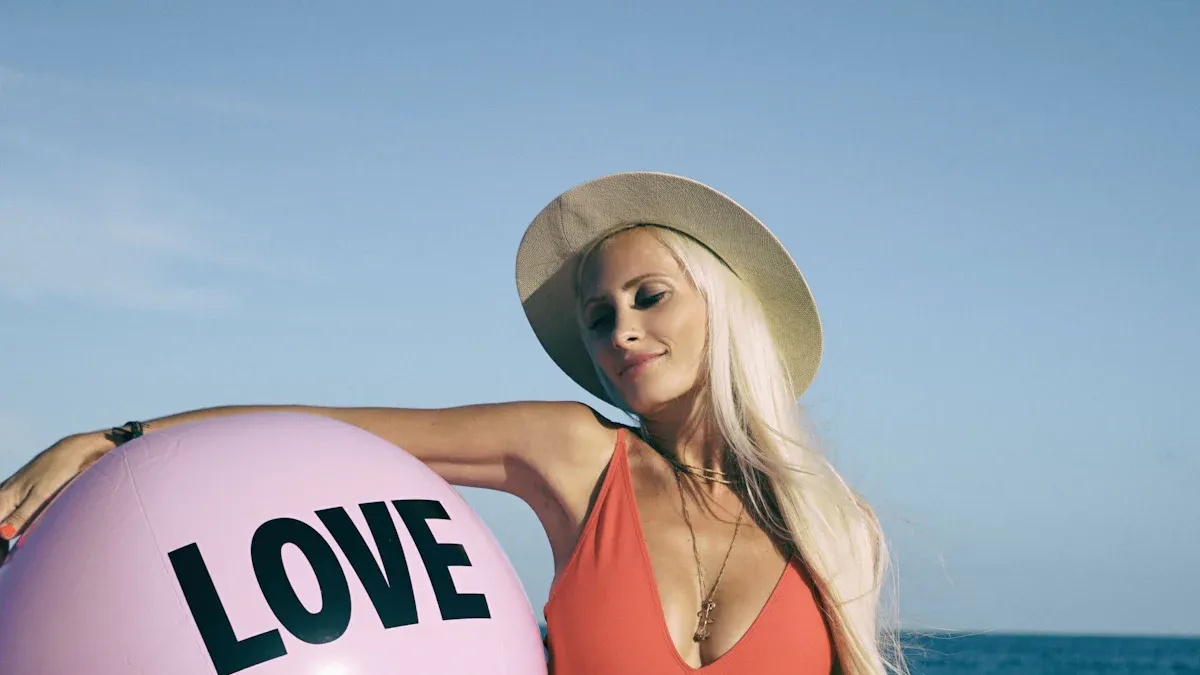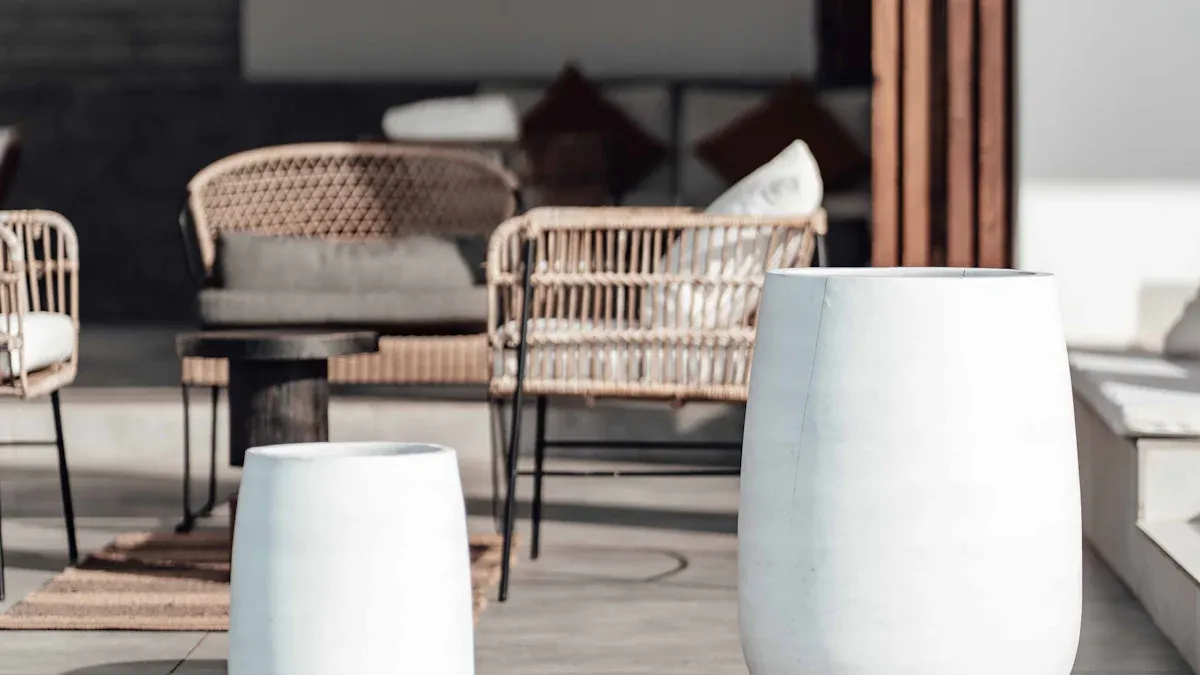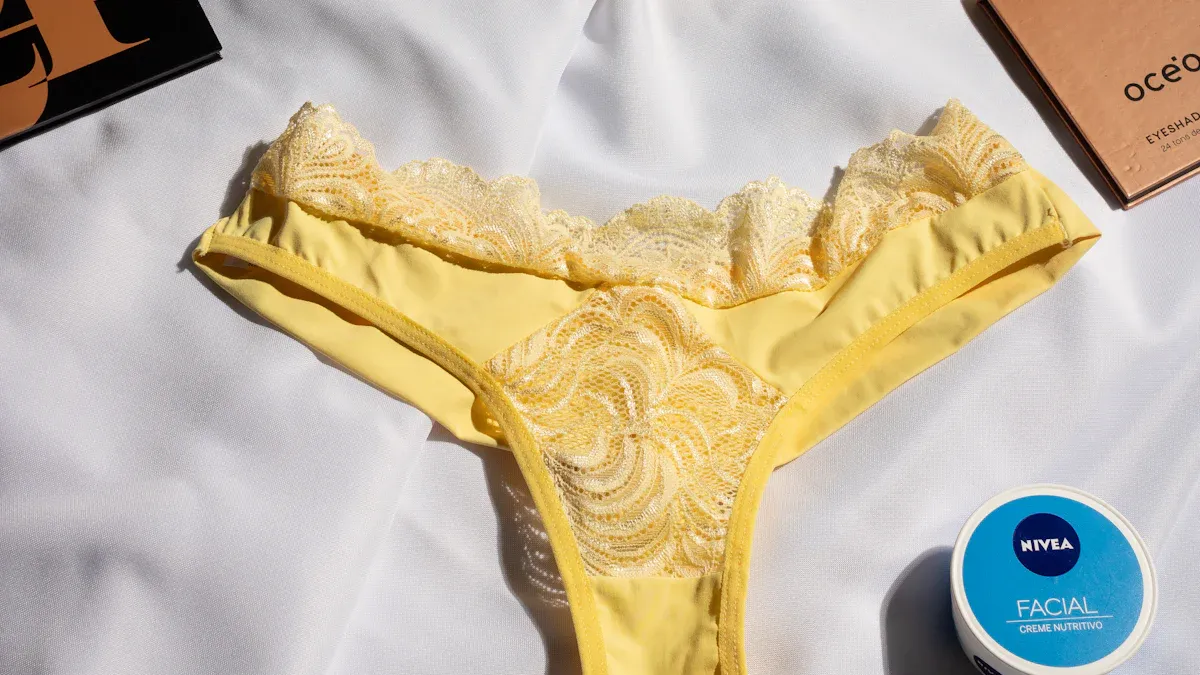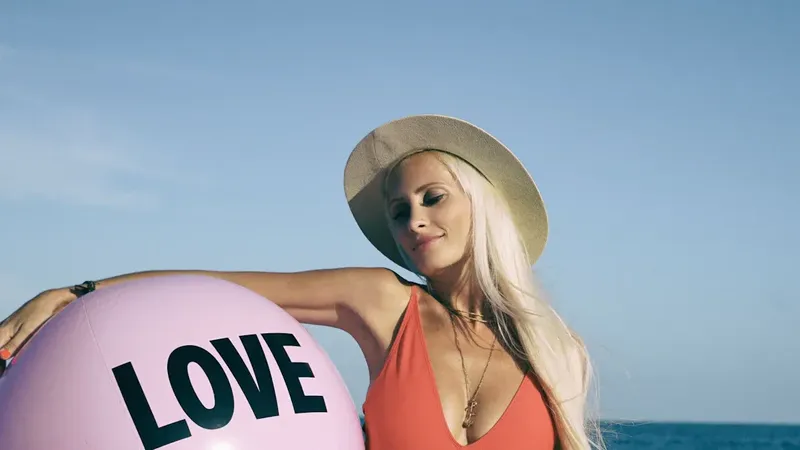
Wenn Sie ein Logo auf Bade bekleidung setzen, hilft es den Menschen, Ihre Marke zu kennen. Sie arbeiten mit einem benutzer definierten Bade bekleidungs hersteller und Designern zusammen, um Ihre Ideen zu verwirklichen. Die Schritte umfassen die Planung des Designs, die Herstellung eines Tech-Packs, das Ausprobieren von Mustern und die Überprüfung der Qualität. Möglicher weise haben SieProbleme wie die Auswahl, wohin das Logo geht, wählen, wie man es drucktUnd stellen Sie sicher, dass das Design auf dem Stoff funktioniert. Sie können diese beheben, indem Sie klar mit Ihrem benutzer definierten Bade bekleidungs hersteller sprechen, sich Muster ansehen und das fertige Produkt überprüfen. Sie müssen auch darüber nachdenken, wie lange es dauert, wie viel es kostet und wie das Logo sowohl auf Bikinis als auch auf einteiliger Bade bekleidung aussieht.
Wichtige Imbiss buden
Wählen Sie einen Bade bekleidungs hersteller, der weiß, wie man Logos hinzufügt. Stellen Sie sicher, dass sie gute Stoffe wie Lycra oder Spandex verwenden. Sie solltenQualität überprüfenSo sieht Ihre Marke gut aus und hält lange.
Denken Sie an Ihr Logo-Design, bevor Sie beginnen. Wählen Sie die beste Stelle, Größe und Farben für Ihr Logo. Wählen Sie Materialien, die zu Ihrer Bade bekleidung und Ihrem Marken stil passen.
Machen Sie ein Tech-Pack mit all Ihren Design-Details. Sagen Sie dem Hersteller, was Sie für Materialien und Logo wollen. Dies hilft, Fehler zu verhindern.
Schauen Sie sich echte Muster Ihrer Bade bekleidung mit dem Logo an. Prüfen Sie, ob Passform, Farbe und Qualität gut sind. Geben Sie ein klares Feedback, wenn Sie Änderungen wünschen.
Geben Sie genug Zeit für die Herstellung Ihrer Bade bekleidung. Es kann 6 bis 9 Monate dauern. Überprüfen Sie immer die Endprodukte, um sicher zustellen, dass sie den Standards Ihrer Marke entsprechen und lange halten.
Die Wahl eines benutzer definierten Bademode-Herstellers

Worauf Sie suchen sollten
Wenn Sie nach einem benutzer definierten Bade bekleidungs hersteller suchen, prüfen Sie, ob dieser weiß, wie er Logos hinzufügt. Top-Bademoden marken wollen Hersteller, die verwendenGute Stoffe wie Lycra und Spandex. Diese Materialien helfen Bikinis und einteilige Bade bekleidung, länger zu halten und ihre Form zu behalten. Gute Stoffe helfen auch Bade bekleidung, Chlor und Sonnenlicht zu widerstehen. Dadurch sieht Ihr Logo hell und klar aus.
Überprüfen Sie, ob der Hersteller viele Stile und Passungen hat. Einige Marken wünschen sich verstellbare Träger oder spezielle Schnitte für ihren Bikini und ihre einteilige Bade bekleidung. Ein guter Hersteller wird Ihnen zeigenProben und PrototypenBevor Sie alle Bade bekleidung machen. Auf diese Weise können Sie sehen, wie Ihr Logo auf verschiedenen Stilen aussieht. Sie können nach Änderungen fragen, wenn Sie sie benötigen.
Qualität der Materialien und Zertifizie rungen
Gute Qualitäts kontrolle für Passform und Stärke
Auswahl möglichkeiten für Design, Stile und Branding
Muster für Bikini und einteilige Bade bekleidung
Erfahrung mit Logo-Platzierung, Verpackung und Branding
Wie viel können sie machen und klare Zeitpläne
Faire Preise und Kosten details
Gute Kommunikation und Kunden service
Bewertungen und Reputation von anderen Bademoden marken
Schauen Sie sich das Portfolio des Herstellers an. Marken wie Speedo und ArenaArbeiten Sie mit Fabriken zusammen, die neue Technologien verwenden und starke Qualitäts kontrollen haben. Zoggs und Billabong wählen Partner aus, die sich um die Umwelt kümmern und kleine Chargen herstellen können. Diese Beispiele zeigen, dass ein gutes Portfolio Ihnen hilft, dem Hersteller Ihre Bade bekleidung anzu vertrauen.
Tipp:Machen Sie klare Skizzen und schreiben Sie Ihre Marken ziele aufBevor Sie mit einem Hersteller von benutzer definierten Bade bekleidung sprechen. Dies hilft ihnen zu wissen, was Sie für Ihren Bikini und Ihre einteilige Bade bekleidung wollen.
Private Label-Optionen
Mit der Eigenmarken produktion können Sie Bade bekleidung mit Ihrer eigenen Marke herstellen. Sie können wählenKunden spezifische verpackungUnd Branding, um Ihren Bikini und Ihre einteilige Bade bekleidung zu etwas Besonderem zu machen. Viele Hersteller verfügen über umwelt freundliche Verpackungen und Branding, recycelte Stoffe und faire Produktion. Diese Auswahl hilft Ihrer Bade bekleidung, sich abzuheben und Ihren Markenwerten zu entsprechen.
Aspekt | Auswirkungen auf den wahrgenommenen Wert |
|---|---|
Anpassung | Einzigartige Designs für Bikini und einteilige Bade bekleidung sorgen dafür, dass sich Ihre Produkte besonders anfühlen. |
Überlegene Qualität | Gute Materialien und sorgfältiges Arbeiten lassen Bade bekleidung gut passen und halten länger. |
Kunden spezifische Verpackung | Umwelt freundliche Verpackung und Branding lassen Ihre Marke besser aussehen. |
Nachhaltig keit | Die Verwendung von recycelten Stoffen und die Herstellung kleiner Chargen ist besser für die Umwelt. |
Ethische Produktion | Faire Arbeit und klare Regeln helfen Kunden, Ihrer Marke zu vertrauen. |
Marken identität | Starke Verpackung und Branding helfen Ihnen, mehr zu verlangen und treue Kunden zu halten. |
Verbraucher vertrauen | Klare Produktion, Verpackung und Branding lassen die Menschen Ihrer Bade bekleidung vertrauen. |
Fragen Sie nach der kleinsten Bestellung, die Sie erstellen können, und Muster regeln. Einige Hersteller geben kostenlose Proben, wenn Sie viel bestellen. Sprechen Sie klar über Zeitpläne, Passform sowie Verpackung und Branding, um später Probleme zu vermeiden.
Logo-Design

Ein starkes Logo hilft Ihrer Bademoden marke, wahrgenommen zu werden. Sie möchten, dass die Leute Ihr Branding auf Bikinis und einteiligen Bade bekleidung sehen. Gute Design entscheidungen lassen Ihre Bade bekleidung profession ell aussehen. Sie helfen auch Ihrem Logo, länger zu halten. Sie sollten darüber nachdenken, wo Sie Ihr Logo platzieren sollen. Sie müssen Farben und Materialien auswählen. Sie müssen Ihre Ideen mit dem teilenHersteller.
Platzierung & Größe
Sie müssen den besten Platz für Ihr Logo auswählen. Die Brust, der Rücken und die Seitenteile sind beliebte Flecken. Diese Bereiche sind auch an geschäftigen Orten leicht zu erkennen. Logos in diesen Spots helfen Menschen, sich an Ihre Marke zu erinnern. Studien sagen, dass Logos hier Menschen helfen können, sich an Ihre Marke zu erinnern80% mehr. Du willst deineLogo auf zufallenAber nicht den Look deiner Bade bekleidung ruinieren.
Sie können verwendenInnen etikettenFür einen ruhigen Blick. Diese Labels sind gut, wenn Sie ein weniger offen sichtliches Branding wünschen. Denken Sie an die Größe Ihres Logos. Wenn es zu groß ist, kann es Ihr Design übernehmen. Wenn es zu klein ist, sehen die Leute es möglicher weise nicht. Wählen Sie eine Größe, die gut passt und den Komfort nicht beeint rächt igt.
Tipp: Versuchen Sie, Ihr Logo an verschiedenen Stellen auf Proben zu platzieren. Dies hilft Ihnen zu sehen, was am besten aussieht und sich anfühlt.
Farbe & Material
Die Wahl der richtigen Farben und Materialien ist wichtig. Ihr Logo sollte zu Ihrer Bade bekleidung passen und lange halten. Polyester und Nylon sind die am häufigsten verwendeten Materialien für Bade bekleidung. Polyester eignet sich am besten zum Drucken von Logos. Es ist stark, behält Farbe und wird nicht durch Chlor ruiniert. Nylon ist weich und dehnt sich gut aus. Aber es behält nicht so gut Farbe und kann durch Chlor beschädigt werden.
Hier ist einTabelle, die zeigt, warum jedes Material für Logos gut ist:
Material | Vorteile für Logo-Anwendung auf Bademode | Hinweise zur Verwendung und Eigenschaften |
|---|---|---|
Polyester | Haltbar, color fast, chlor beständig, schnell trocknend, hält Farbe gut, ideal für Siebdruck logos | Bevorzugter Stoff für Bademoden-Logos aufgrund von Haltbarkeit und Druck tauglichkeit |
Nylon | Weich, langlebig, abriebfest, dehnbar, schnell trocknend | Beliebt, aber weniger Farb retention, anfällig für Chlors chäden, weniger ideal für den Sublimation druck |
Elastan | Bietet Stretch und Flexibilität, perfekt für Passform und Komfort | Verwendet gemischt mit anderen Stoffen für Elastizität, nicht primär für Logo-Druck |
PBT | Chemikalien beständig, langlebig, color fast, schnell trocknend | Weniger dehnbar, gut für wettbewerbs fähige Bade bekleidung, weniger häufig für Logos |
Wählen Sie Logo farben, die zu Ihrer Marke passen und gut aussehen. Helle Farben können auffallen. Aber stellen Sie sicher, dass sie nach dem Schwimmen nicht verblassen. Testen Sie Ihr Logo auf verschiedenen Materialien. Dies hilft Ihnen zu sehen, welche Farbe und Form am besten hält.
Stark und schrumpft nicht
Bleibt gut in Chlor
Hält die Farbe gut
Trocknet schnell
Schützt vor UV
Streckt sich aus und behält seine Form
Fühlt sich weich und bequem an
Nylon:
Weich und stark
Wird nicht leicht zerkratzt oder befleckt
Streckt und prallt zurück
Guter Sonnenschutz
Trocknet schnell
Hält nicht Farbe und Polyester
Kann durch Chlor ruiniert werden
Details zum Tech Pack
Du brauchst eineTech-PackUm dem Hersteller Ihre Ideen zu zeigen. Ein Tech-Pack ist ein Papier mit allen Details zu Ihrer Bade bekleidung, Ihrem Logo und Ihrem Branding. Es hilft, Fehler zu stoppen und stellt sicher, dass Ihre Bade bekleidung richtig aussieht. Tech-Packs haben Zeichnungen, Größen, Materialien und Logo-Anweisungen.
Hier ist, was Sie in Ihr Tech-Pack stecken sollten:
Material info: Listen stoffe, Farben, Oberflächen und Lieferanten.
Teile: Beschreiben Sie Schaltflächen, Drucke, Etiketten, Fäden und andere Stücke.
Bestell informationen: Fügen Sie Liefertermine, Adressen hinzu und wer die Bestellung erhält.
Feedback & Proben: Überprüfen Sie die Proben, um sicher zustellen, dass die Qualität gut ist, bevor Sie viel machen.
Menge & Größe: Verwenden Sie Diagramme, um Größen zu zeigen und wie viele Sie wollen.
Zeichnungen und Größen: Fügen Sie Computer zeichnungen, passende Details und Notizen hinzu.
Flache Skizzen: Zeigen Sie die Form und Größe Ihrer Bade bekleidung und Ihres Logos.
Konstruktion hinweise: Enthalten Sie Messungen, Materialien und Naht räume.
Stoff farben: Verwenden Sie Pantone-Zahlen für die Farb genauigkeit.
Montage schritte: Geben Sie Schritt für Schritt Anweisungen für die Herstellung Ihrer Bade bekleidung.
Verpackungs informationen: Listen-Tags, Etiketten und Verpackungs details.
Tech-Packs helfen Ihnen, mit Designern und Herstellern zu sprechen. Sie helfenStoppen Sie Fehler und Verwirrung. Sie erhalten jedes Mal die gleiche Qualität und den gleichen Stil. Tech-Packs helfen Muster herstellern, die richtigen Muster zu erstellen. Das macht die Passform besser und stoppt Probleme wie kaputte Gurte. Die Verwendung eines Tech-Packs spart Zeit und Geld. Sie brauchen nicht viele Proben oder teure Änderungen.
Hinweis: Überprüfen Sie Ihr Tech Pack immer mit Ihrem Designer, bevor Sie es an den Hersteller senden. Dies hilft Ihnen, Fehler zu finden und sicher zustellen, dass Ihr Branding richtig ist.
Einreichung & Probenahme
Wenn Sie der benutzer definierten Bade bekleidung ein Logo hinzufügen, müssen Sie einen klaren Prozess für die Einreichung und Probenahme befolgen. Dieser Schritt hilft Ihnen zu sehen, wie Ihr Logo sowohl auf Bikini-als auch auf einteiligen Stilen aussieht, bevor Sie mit der vollständigen Produktion beginnen. Sie können die Passform, Farbe und Qualität Ihrer Bade bekleidung überprüfen und bei Bedarf Änderungen vornehmen.
Dateiformate
Sie sollten Ihr Logo im richtigen Dateiformat senden. Die meisten Hersteller fragen nach Vektor dateien wie. KI,. EPS, oder. PDF. Diese Dateien halten Ihr Design scharf und klar auf allen Bademoden-Stilen. Wenn Sie eine Pixel datei wie verwenden. JPG oder. PNG, das Logo kann verschwommen aussehen, wenn es auf einen Bikini oder ein Stück gedruckt wird. Überprüfen Sie immer mit IhremHerstellerÜber ihr bevorzugtes Format.
Tipp: Fügen Sie Ihr Logo in verschiedenen Größen und Farben ein. Dies hilft dem Hersteller zu testen, wie es auf verschiedenen Bademoden stoffen aussieht.
Stichproben überprüfung
Nachdem SieReichen Sie Ihr Logo einUnd Tech Pack erstellt der Hersteller eine Probe. Sie sehen Ihr Logo auf echten Bade bekleidung wie einem Bikini oder einem Einteiler. Dies ist Ihre Chance, die Passform, Platzierung und Farbe zu überprüfen. Sie sollten immer die physische Probe überprüfen, nicht nur Fotos. Fotos zeigen nicht die wahre Qualität oder Passform der Bade bekleidung. Probieren Sie die Probe aus, um fest zustellen, ob die Passform Ihren Erwartungen entspricht. Überprüfen Sie das Logo auf Schärfe und Farbe sowohl auf Bikini-als auch auf einteiligen Proben.
Überarbeitungen
Wenn Sie Probleme mit der Probe finden, können Sie um Änderungen bitten. Hersteller bieten Revisions runden an, damit Sie die perfekte Passform und das perfekte Design erhalten. Sie sollten ein klares Feedback geben, nachdem Sie die physische Probe erhalten haben. Verwenden Sie Ihr Tech-Pack, um darauf hinzuweisen, was repariert werden muss. Die meisten Verzögerungen treten auf, wenn Details zum Tech-Pack fehlenSo detailliert wie möglich sein. Jede Revisions runde kann zusätzliche Kosten verursachen und Ihrer Bestellung Zeit hinzufügen. HerstellerIhnen helfen, fehlende Details auszufüllenWenn Ihr Tech-Pack nicht vollständig ist. Sie helfen Ihnen auch, Etiketten und Zubehör in dieser Phase fertig zustellen. Dieser Prozess stellt sicher, dass Ihre Bade bekleidung, ob Bikini oder einteilig, den Standards Ihrer Marke für Passform und Design entspricht.
Anmerkung:Geben Sie Feedback über den zugewiesenen Merchandiser. Dies hält die Kommunikation klar und hilft, Fehler zu vermeiden.
Produktion & Qualität
Zeitleiste
Sie müssen frühzeitig für benutzer definierte Bade bekleidung mit einem Logo planen. Die Herstellung von benutzer definierten Bade bekleidung nimmt mehr Zeit in Anspruch als normale Bade bekleidung. Der ganze Prozess kann dauern6 bis 9 Monate. Es gibt mehrere Schritte, die Sie befolgen müssen:
Das Erhalten von Materialien dauert etwa 3 bis 4 Wochen.
Die Probenahme braucht viele Runden. Jede Runde dauert 4 bis 6 Wochen. Möglicher weise verbringen Sie 2 bis 3 Monate nur mit der Probenahme.
Die Herstellung der Bade bekleidung hängt davon ab, wie viel Sie bestellen. Kleine Bestellungen dauern ca. 3 Wochen. Großaufträge können bis zu 4 Monate dauern.
Der schnelle Versand dauert 3 bis 5 Tage.
Benutzer definierte Bade bekleidung dauert länger, da Sie Tech-Packs überprüfen, Muster ansehen und die Passform testen müssen. Sie müssen auch sehen, wie das Logo auf Bikinis und einteiligen Stilen aussieht. Regelmäßige Bade bekleidungs proben sind in wenigen Tagen fertig. Custom Designs brauchen mehr Schritte und Änderungen.
Tipp: Beginnen Sie früh mit der Planung. Geben Sie sich zusätzliche Zeit für Proben und Änderungen. Dies hilft Ihnen, Verzögerungen zu vermeiden und stellt sicher, dass Ihre Bade bekleidung genau richtig ist.
Das Hinzufügen eines Logos kann Ihre Kosten ändern. Sie können wählenBenutzer definierte Etiketten, Stickerei oder Druck. Jede Auswahl erhöht Ihre Branding-und Marketing kosten. Stickerei hebt Ihr Logo hervor und hält lange. Der Druck funktioniert wie Siebdruck oder Wärme übertragung für bunte Logos. Benutzer definierte Etiketten lassen Ihre Bade bekleidung profession ell aussehen. Diese Entscheidungen helfen Ihrer Marke, auf sich aufmerksam zu machen, aber Sie sollten sie in Ihrem Budget einplanen.
Haltbarkeit
Sie möchten, dass Ihre Bade bekleidung in Sonne, Salz und Chlor hält. Gute Materialien helfen Ihrem Logo, hell und klar zu bleiben. Polyester und andere starke Stoffe verblassen oder dehnen sich nicht leicht. Diese Stoffe behalten nach vielen Schwimmen ihre Farbe und Form. Sie sollten Ihr Logo immer sowohl auf Bikini-als auch auf einteiligen Proben testen. Das zeigt, wie das Logo nach echtem Gebrauch aussieht.
Qualitäts kontrolle beginnt mit der Auswahl guter Materialien. Sie brauchen Stoffe, die Farbe halten, sich gut dehnen und stark sind. Nähte müssen auch stark sein. Gute Nähte verhindern, dass Ihre Bade bekleidung auseinander fällt. Bade bekleidung sollte in allen Größen gut passen, damit sich jeder wohl fühlt. Sie sollten die Passform sowohl für Bikinis als auch für einteilige Stile während der Probenahme überprüfen.
Hersteller nutzen intelligente Wege, um weniger Abfall und bessere Qualität zu machen. Sie arbeiten mit vertrauens würdigen Lieferanten für die besten Materialien. Die Schulung von Mitarbeitern hilft, Fehler zu stoppen und bessere Produkte zu machen. Mit dem Digitaldruck haben Sie detaillierte Logos für weniger Geld. Regelmäßige Kontrollen während der Herstellung helfen, Probleme frühzeitig zu finden.
Warum es wichtig ist | |
|---|---|
Material auswahl | Hält Farbe und Form nach dem Schwimmen |
Haltbarkeit der Nähte | Verhindert das Auflösen und verlängert die Lebensdauer |
Konsequente Passform | Sorgt für Komfort für alle Körper typen |
Logo-Prüfung | Überprüft Farbe und Schärfe nach Gebrauch |
Regelmäßige Audits | Findet Mängel vor dem Versand |
Hinweis: Fragen Sie Ihren Hersteller immer nach seinen Qualitäts prüfungen. Dies hilft Ihnen, darauf zu vertrauen, dass Ihre Bade bekleidung hält und gut aussieht.
Endkontrolle
Bevor Sie zu Ihrer Bestellung Ja sagen, müssen Sie eine letzte Überprüfung durchführen. Dieser Schritt stellt sicher, dass jedes Stück Bade bekleidung gut ist. Sie sollten sich ansehen, wo sich das Logo befindet, seine Farbe und ob es klar ist. Stellen Sie sicher, dass die Passform sowohl für Bikinis als auch für einteilige Stile zu Ihren Proben passt. Überprüfen Sie die Nähte und den Stoff auf Probleme.
Sie sollten eine Checkliste verwenden, wenn Sie Folgendes inspizieren:
Stellen Sie sicher, dass das Logo klar und an der richtigen Stelle ist.
Testen Sie die Passform auf verschiedene Größen und Stile.
Schauen Sie sich die Nähte an, um fest zustellen, ob sie stark und ordentlich sind.
Stellen Sie sicher, dass die Farben übereinstimmen und der Stoff gut ist.
Überprüfen Sie die Verpackung und die Etiketten, um fest zustellen, ob sie korrekt sind.
Wenn Sie Probleme finden, informieren Sie sofort Ihren Hersteller. Die meisten Fabriken reparieren die Dinge, bevor sie Ihre Bestellung versenden. Durch die Endkontrolle fühlen Sie sich sicher, dass Ihre Bade bekleidung den Standards Ihrer Marke entspricht. Es hilft Ihnen auch, Renditen und unglückliche Kunden zu vermeiden.
Denken Sie daran: Sorgfältige End prüfungen schützen Ihre Marke und halten die Kunden zufrieden.
Wenn Sie ein Logo auf benutzer definierte Bade bekleidung setzen, müssen Sie einige Schritte befolgen. Sprechen Sie zunächst mit Ihrem Bade bekleidungs anbieter darüber, wohin das Logo gehen soll. Sie sprechen auch darüber, wie das Logo aussehen soll. Wählen Sie als Nächstes eine Druck methode aus, die zu Ihrem Marken stil passt. Bevor Sie die Bade bekleidung herstellen, überprüfen Sie jedes Detail, um sicher zustellen, dass es richtig ist. Gute Kommunikation mit Ihrem HerstellerHilft, Fehler zu stoppen. Es hält auch Ihr Projekt voran. Schauen Sie sich die Proben an und überprüfen Sie die fertige Bade bekleidung aufQualität. Stellen Sie sicher, dass die Nähte und das Logo gut aussehen. Konzentrieren Sie sich darauf, wie lange die Bade bekleidung hält und wie sie Ihre Marke zeigt. Benutzer definierte Bademode mit Ihrem Logo macht Ihre Marke leicht zu sehen. Es hilft Ihnen auch, stolz auf jedes Stück zu sein.
Tipp: Verwenden Sie immer Mess hilfen und fragen Sie Ihren Bademoden anbieter um Feedback. Dies hilft Ihnen, eine bessere Passform und ein besseres Aussehen zu bekommen.
Wichtige Schritte zur Zufriedenheit:
Sprechen Sie über die Auswahl von Logos und wo Sie sie platzieren können.
Schauen Sie sich verschiedene Druck methoden für den besten Stil an.
Überprüfen Sie die Designs, bevor Sie die Bade bekleidung herstellen.
Sprechen Sie klar mit Ihrem Bade bekleidungs hersteller.
Überprüfen Sie Ihre Bade bekleidung, wenn Sie sie erhalten.
Benutzer definierte Bade bekleidung mit Ihrem Logo hilft den Leuten, Ihre Marke zu bemerken. Damit können Sie Produkte herstellen, die den Menschen Spaß machen.
FAQ
Wie wählen Sie die beste Logo-Platzierung auf Bade bekleidung?
Sie sollten beliebte Stellen wie Brust, Rücken oder Seitenteile betrachten. Probieren Sie Proben mit Ihrem Logo an verschiedenen Orten aus. Wählen Sie die Stelle, die auf fällt und zu Ihrem Marken stil passt.
Welchen Dateityp sollten Sie für Ihr Logo verwenden?
Sie sollten Ihr Logo als Vektor datei senden, wie z. KI,. EPS, oder. PDF. Diese Dateien halten Ihr Logo scharf und klar, wenn sie auf Bade bekleidung gedruckt werden.
Können Sie jede Farbe für Ihr Logo auf Bade bekleidung verwenden?
Sie können jede Farbe auswählen, aber Sie sollten es zuerst testen. Einige Farben verblassen schneller in Sonne oder Chlor. Helle Farben sehen oft am besten aus und halten länger auf Bade bekleidung.
Wie lange dauert es, benutzer definierte Bade bekleidung mit einem Logo herzustellen?
Sie sollten für 6 bis 9 Monate planen. Diese Zeit beinhaltet Design, Probenahme, Produktion und Versand. Frühes Starten hilft Ihnen, Verzögerungen zu vermeiden.
Was hilft Ihrem Logo, auf Bade bekleidung länger zu halten?
Sie sollten starke Stoffe wie Polyester wählen. Gute Druck methoden wie Siebdruck oder Stickerei tragen auch dazu bei, dass Ihr Logo nach vielen Schwimmen hell und klar bleibt.
